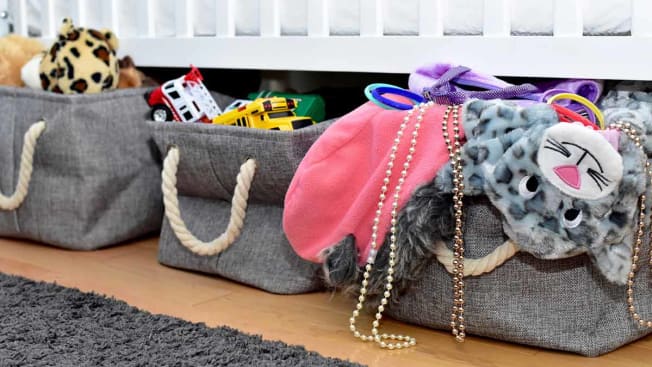Under-the-Bed Storage Options to Help Banish Clutter
Posted by admin on
Experts share their tips and go-to tools for tackling common storage space problems

By Anna Kocharian
Ask any small home or apartment dweller about the amount of storage space they’re working with and chances are they’ll tell you they could use more. Finding creative and efficient ways to carve out room for everything could practically be considered an Olympic sport, especially for those living with limited square footage.
That’s why Consumer Reports turned to professional organizers for some do’s and don’ts, specifically for under-the-bed storage, to help apply a bit of method to the madness.
Before You Buy
Off-season attire, shoes, luggage, and spare bedding are just some of the items that can’t always fit into a closet filled with clothes, but space under the bed is a zone primed to help conceal that clutter.
Before you start filling that area though, experts recommend careful planning instead of acting out of desperation. “It’s best to store things there that you don’t need to access every day, since it’s somewhat inconvenient,” says Sharon Lowenheim, a certified professional organizer and founder of Organizing Goddess.
Lay out the items you need storage space for to get a visual sense of what you’ll be working with. Group like pieces together and use this exercise as an opportunity for a purge. You can toss out, recycle, or donate items you no longer need.
Decide What You Want Under the Bed
“Consider what you want vs. need to store underneath—the frequency of use, accessibility, and space constraints,” says Jeanie Engelbach, professional organizer and founder of Apartmentjeanie. “If the plan is to extend the storage capacity of your wardrobe, then you want category-specific storage rather than bigger containers that hold more.” So avoid tossing everything into a large, bulky bin and calling it a day.
Measure Twice, Buy Once
Storing all your essentials in designated spaces can seem simple enough, but in reality, it may take some planning. First, measure out the amount of room you can allot to storage. Note the distance from the floor to the side rail of the bed (as opposed to the base of where the mattress sits) to give yourself room to easily slide the containers in and out. Once you have a better understanding of the bin size you’ll need, make sure they can all fit under the bed.
Go for Covered Containers
Despite being out of sight, the space under the bed is not immune to dust, so finding lidded storage is key. This is especially true for bedding, linens, and clothing, which can benefit from airtight containers or storage bags to protect them from dust mites, mildew, and absorbing odors. “It gets dusty under the bed in the cleanest of homes,” says Karin Socci, founder of The Serene Home, a professional organization service.
While you may find plastic bins in a range of shapes and sizes, alternatives include polypropylene storage cases for a less structured approach, or bamboo or solid wood for those who prefer a more natural route.

meyes
How to Store the Basics
Because there isn’t a one-size-fits-all strategy for under-the-bed storage, each category or group of items can benefit from a dedicated approach. The professional organizers we spoke with break it down.
Shoes
With shoes, you have two groups to work with—the pairs you wear every day and the ones that are better reserved for special occasions or alternate seasons. Regardless of which you’re storing, they should always be enclosed, Socci says. This is important to keep the shoes from gathering dust and prevent odors from seeping out. She also recommends using lidded bins with wheels when possible (for easy accessibility) and avoiding fabric shoe bins because they don’t hold their shape and tend to collapse.
Containers with a drawer-like functionality are also convenient for everyday use. Lowenheim and Engelbach recommend a stackable underbed drawer; that comes with the bonus of keeping contents visible yet dust-free.
Where to buy shoe storage: $27.98 at Home Depot; $30 at the Container Store; $108 for a set of four at Amazon; $130 for set of four at Walmart
Linens and Bedding
Linen closets are right up there on the list of underrated luxuries in a home. Spare bedding and towels can take up a significant amount of space, and if you don’t have storage in the bathroom, the area underneath the bed might just be the next best solution.
Given that bedding tends to be heavier, opt for a container with wheels for lightweight mobility. Lowenheim suggests a long underbed box that also features a hinged lid for even easier access.
Unless you’re going for containers with drawers, avoid a stacked setup so you won’t have to lift and lower a bulky bin every time you need a new pillowcase.
Where to buy linen and bedding storage: $32 at the Container Store; $25 for a similar one at Target

Kristin Mitchell
Off-Season Clothing
Under-the-bed storage is ideal for off-season clothing because it’s possible to go months at a time without needing them. Before packing these items away, be sure to thoroughly launder them to preserve the integrity and cleanliness of the entire stack—unwashed clothing will not only spread odors from item to item but also attract critters. Toss in a couple of fresh cedar blocks as an extra precaution against moths.
To figure out what kind of container you need for the clothing you want to store under your bed, consider the space you have and how much clothing you will need to store. Lowenheim’s go-to is a modular bin that’s stackable and space-efficient. Its locking lid, which will keep your staples secure from critters, is a plus.
If you prefer to go with a more breathable alternative, which Engelbach says can help your clothes last longer, containers made from natural fibers will be your best bet. She suggests compressed felt storage bins or a zippered canvas storage bag.
Where to buy off-season clothing storage: Stackable, modular bin, $20 at the Container Store; Zippered canvas storage bag, $36.85 at Lands’ End
Odds and Ends
Your toolbox, batteries, a package of spare lightbulbs, or other miscellaneous items might not quite fit anywhere else and end up in a cluttered box under the bed. Think of it as the equivalent of a junk drawer—a concept Lowenheim says can be functional if the containers are shallow, enabling you to see everything in them. And a little organization within can go a long way.
If your odds and ends are items that you’ll need regular access to, like gym clothes, electronics, or socks, Socci suggests using an extra-large drawer that can slide out with ease such as the solid wood drawer below. To keep things extra-tidy, you can also bring in smaller organizational elements that can live within the drawer, like dividers or compartmentalized bins.
For items you need to keep on hand but use only periodically, such as documents or books, Engelbach recommends the rolling lidded storage bin below, made even more convenient with its cut-out handles. You can use this as a makeshift filing cabinet that can hold it all.
But that doesn’t mean you should keep it all. “If you are storing things under your bed simply because you may need them someday, or you feel guilty for letting them go, consider why you are keeping them in the first place,” Socci says.
Where to buy storage for odds and ends: Solid wood storage drawer, $67 at Amazon, Walmart; Rolling lidded storage bin, $40 at the Container Store, $25 for a similar one at Wayfair
Consumer Reports is an independent, nonprofit organization that works side by side with consumers to create a fairer, safer, and healthier world. CR does not endorse products or services, and does not accept advertising. Copyright © 2022, Consumer Reports, Inc.
